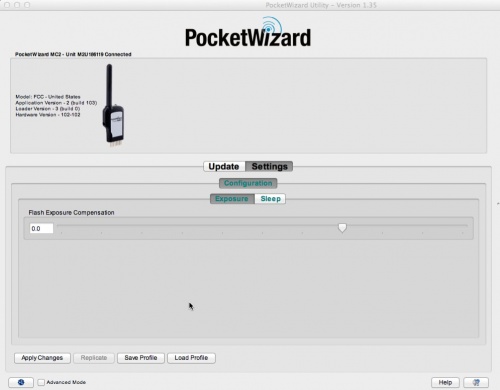Difference between revisions of "Exposure Tab"
| Line 2: | Line 2: | ||
[[File:Exposure.jpg|500px|center|Exposure Tab]] | [[File:Exposure.jpg|500px|center|Exposure Tab]] | ||
| + | |||
The Exposure Tab is only used / present for [[PowerST4]] and [[PowerMC2]] radios. | The Exposure Tab is only used / present for [[PowerST4]] and [[PowerMC2]] radios. | ||
| Line 7: | Line 8: | ||
The Flash Exposure Compensation feature, located under the Exposure tab allows for manually offsetting the power levels of an individual remote strobe connected to the radio. | The Flash Exposure Compensation feature, located under the Exposure tab allows for manually offsetting the power levels of an individual remote strobe connected to the radio. | ||
| − | For example, take two Einstein flashes connected to two PowerMC2 radios, set for Zone A. Normally, these two flashes will respond to power level changes from the transmitting radios identically. | + | For example, take two Einstein flashes connected to two PowerMC2 radios, set for Zone A. Normally, these two flashes will respond to power level changes from the transmitting radios identically. You could configure a ratio between these flashes within that group via the Flash Exposure Compensation control, by dropping or raising the power level of one flash relative to the default "0" value. |
| − | In the above example, setting -1 compensation for one of the flashes would cause that flash to always be one stop less than the power level sent from the transmitting radio | + | In the above example, setting -1 compensation for one of the flashes would cause that flash to always be one stop less than the power level sent from the transmitting radio, while the flash & radio with 0 compensation would respond normally. |
| − | Note that the flash will still only be able to reach it's normal minimum or maximum power values - this setting only shifts the power level relative to the incoming power level command. | + | Note that the flash will still only be able to reach it's normal minimum or maximum power values - this setting only shifts the power level up or down relative to the incoming power level command. |
Latest revision as of 13:31, 31 August 2011
| Utility Tab Quick Links |
| Update |
| Channel |
| Flash |
| HyperSync/HSS |
| PowerTracking |
| Modeling |
| Sleep |
| Misc |
| Exposure |
The Exposure Tab is only used / present for PowerST4 and PowerMC2 radios.
The Flash Exposure Compensation feature, located under the Exposure tab allows for manually offsetting the power levels of an individual remote strobe connected to the radio.
For example, take two Einstein flashes connected to two PowerMC2 radios, set for Zone A. Normally, these two flashes will respond to power level changes from the transmitting radios identically. You could configure a ratio between these flashes within that group via the Flash Exposure Compensation control, by dropping or raising the power level of one flash relative to the default "0" value.
In the above example, setting -1 compensation for one of the flashes would cause that flash to always be one stop less than the power level sent from the transmitting radio, while the flash & radio with 0 compensation would respond normally.
Note that the flash will still only be able to reach it's normal minimum or maximum power values - this setting only shifts the power level up or down relative to the incoming power level command.
